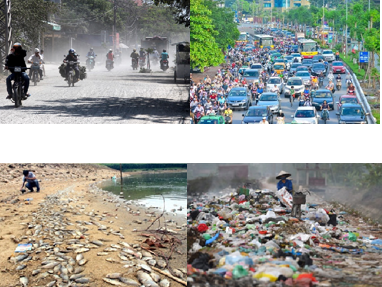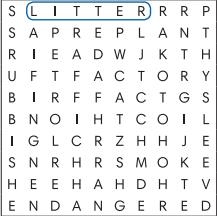Giải SGK, SBT Unit 2. What a waste! English Discovery
Giải SGK, SBT Unit 2. What a waste! English Discovery
1 Study the Vocabulary A box. Find two things that are not in the poster.
(Học từ vựng hộp A. Tìm hai thứ không có trong tấm áp phích.)
|
Vocabulary A Pollution (Từ vựng A) (Ô nhiễm) |
|
bin factory litter endangered animal |
Từ vựng:
bin (n): thùng rác
factory (n): nhà máy
litter (n): rác
endangered animal (n): động vật có nguy cơ tuyệt chủng
oil (n): dầu
petrol (n): xăng dầu
plants (n): thực vật
rubbish (n): rác
smoke (n): khói
traffic (n): giao thông
5 Match the words on the left with the words on the right. Complete the blog post with the correct form of compound nouns from the Vocabulary B box.
(Nối các từ ở bên trái với các từ ở bên phải. Hoàn thành bài viết blog với dạng đúng của danh từ ghép từ hộp Từ vựng B.)
|
Vocabulary B Compound nouns (Từ vựng B) (Danh từ ghép) |
|
1 traffic a bank |
Is it cool to be GREEN?
Definitely! We need to protect our planet for our future. That’s why I always travel on public transport. Too many people drive, so there are always in the city centre. At my school, we recycle as much as we can. We don’t use such as sun or wind power, but our head teacher has plans for solar panels on the roof. Some people joke that they like warmer weather, but I tell them that is really not good. Rising ocean levels cause floods that can destroy houses and farms. The oceans are also getting polluted with plastic, so I never use plastic bags. In fact, I make my own bags! Next to my school there’s a
where we put soft drink bottles, but you can also use the bins for recycling cans, paper and clothes. There’s a larger outside the city, where we can take our old TVs, furniture, books and even bicycles. You can find loads of cool things there.
Từ vựng:
traffic (n): giao thông
bank (n): ngân hàng
bottle (n): cái chai
energy (n): năng lượng
petrol (n): xăng dầu
centre (n): trung tâm
public (n): công cộng
transport (n): chuyên chở
renewable (n): tái tạo
change (n): thay đổi
recycling (n): tái chế
station (n): ga tàu
climate (n): khí hậu
jam (n): mứt
1 Which of the things below do not produce energy?
(Những vật nào dưới đây không sinh ra năng lượng?)
|
jellyfish milk natural gas sugar sun wind |
Từ vựng:
jellyfish (n): con sứa
milk (n): sữa
natural (n): tự nhiên
gas (n): khí ga
sugar (n): đường
sun (n): mặt trời
wind (n): gió
3 Read the Grammar box. Underline question words before to-infinitive verbs in the text in Exercise 2.
(Đọc hộp ngữ pháp. Gạch chân các từ để hỏi trước động từ nguyên thể có to trong bài tập 2.)
|
Grammar Question words before to-infinitive verbs |
|
Question words can be used before to-infinitive verbs to form a question or to express uncertainty or curiosity about an action. For example: (Các từ để hỏi có thể được dùng trước động từ to infinitive để tạo thành một câu hỏi hoặc để diễn tả sự không chắc chắn hay tò mò về một hành động. Ví dụ:) (Tôi không biết phải làm gì để bảo vệ môi trường.) (Cô ấy không biết đi đâu vào kỳ nghỉ hè của mình.) (Họ không biết khi nào nên rời khỏi bữa tiệc.) (Buổi thuyết trình đang đến. Tôi không biết phải bắt đầu như thế nào.) |
2 Study the Speaking box. Find more examples of agreeing and disagreeing phrases in the dialogue.
(Nghiên cứu hộp Nói. Tìm thêm ví dụ về các cụm từ đồng ý và không đồng ý trong đoạn hội thoại.)
|
Speaking (Nói) |
Agreeing and disagreeing |
|
Agreeing I think that’s a good / great idea. (Tôi nghĩ đó là một ý tưởng hay/tuyệt vời.) (Có lẽ bạn nói đúng.) (Tôi cũng nghĩ thế.) (Tôi hoàn toàn đồng ý.) (Chắc chắn!) (Bạn có thể nói lại điều đó!) (Tôi cho là/đoán vậy.) |
Disagreeing I don’t agree. (Tôi không đồng ý.) (Đúng, nhưng…) (Điều đó không phải lúc nào cũng đúng.) (Tôi không nghĩ vậy.) (Tôi không nghĩ chúng ta nên…) (Tôi không chắc về điều đó.) |
3 Read the Writing box and underline the structures used in the paragraph above.
(Đọc phần Viết và gạch chân các cấu trúc được sử dụng trong đoạn văn trên.)
|
Writing Expressing importance |
|
It is important / essential / necessary / vital / imperative / crucial + to verb: It is important to recycle plastic to reduce waste. (Điều quan trọng là tái chế nhựa để giảm chất thải.) (Điều quan trọng là phải tiết kiệm nước trong thời kỳ hạn hán.) (Điều quan trọng/thiết yếu/cần thiết/quan trọng/mệnh lệnh/quan trọng + that + chủ ngữ + động từ:) (Điều quan trọng là các gia đình, trường học và văn phòng phải giảm thiểu rác thải nhựa.) (Nó là điều quan trọng nhất + to-V:) |
2 Complete the sentences with the words and phrases below.
(Hoàn thành câu với các từ và cụm từ dưới đây.)
|
endangered animal public transport |
Tạm dịch:
endangered animal: động vật có nguy cơ tuyệt chủng
public transport: phương tiện giao thông công cộng
recycling centre: trung tâm tái chế
rubbish: rác
throw away: vứt đi
1 Do you usually throw away your old clothes?
(Bạn có thường vứt quần áo cũ đi không?)
2 Do you know where the nearest is?
3 Do you think people should use instead of their own cars?
4 If you see in the street, do you pick it up?
5 Which would you help protect?
4 Complete the diary entry with the Past Perfect form of the verbs below.
(Hoàn thành mục nhật ký với dạng Quá khứ hoàn thành của các động từ bên dưới.)
|
cause choose forget not arrive not have plan |
Tạm dịch:
cause: gây ra
choose: chọn
forget: quên
not arrive: không đến
not have: không có
plan: kế hoạch
Thursday was our school trip. I was excited because our teacher had planned a day at a wind farm. She the biggest wind farm in Scotland with more than 200 wind turbines. But when we got to school in the morning, the bus and we had to wait for ages. We heard that an accident in the town centre a huge traffic jam. When it finally came, I was starving because I my packed lunch. It was a really long journey and when we got to the farm, the wind turbines weren’t moving. The farm any wind that week!
5. Complete the comments with the words below.
(Hoàn thành các bình luận bằng các từ bên dưới.)
|
bank |
bin |
change |
endangered |
factories |
|
litter |
oil |
recycling |
traffic |
transport |
1. Too many people throw away bottles in the (a) _______. They should take them to a bottle (b) _______.
2. Using (a) _______ as an energy source is one of the biggest causes of climate (b) _______.
3. Since the government improved public (a) _______ in this city, there are fewer (b) _______ jams in the morning.
4. Our city needs more (a) _______ centres. I often see people throw away bottles and cans as (b) _______.
5. Water and land pollution from the (a) _______ in the area affects (b) _______ animals.
1. Match the phrases below with definitions 1-5.
(Ghép các cụm từ dưới đây với định nghĩa từ 1-5.)
|
environmental laws |
greenhouse gases |
sign a petition |
|
take legal action |
win a court case |
1. carbon dioxide and methane are examples of these greenhouse gases: _______
2. add your name to a list of people who are asking the government to do something: _______
3. successfully challenge a person or organisation in court: _______
4. rules that people and businesses must follow which protect the land, sea and air: _______
5. try to change a situation using lawyers: _______
1. Match 1-6 with a-f to make phrases.
(Nối 1-6 với a-f để tạo thành cụm từ.)
|
1. Maybe |
a. sure about that. |
|
2. I totally |
b. don’t agree. |
|
3. That’s not |
c. you’re right. |
|
4. I’m not |
d. agree. |
|
5. I think that’s a |
e. great idea. |
|
6. Really? I |
f. always true. |
1. Put the following items into the correct column: recyclable and not recyclable.
(Xếp các mục sau vào đúng cột: có thể tái chế và không thể tái chế.)
|
plastics |
cardboard |
paper towels |
food waste |
|
aluminium foil |
paper grocery bags |
battery |
light bulbs |
|
juice and milk cartons |
medical containers |
newspaper |
|
Recyclable |
Not recyclable |
2. Choose a word from A and a word from B to complete the sentences.
(Chọn một từ trong phần A và một từ trong phần B để hoàn thành câu.)
|
A |
B |
|
climate endangered public renewable throw |
animals away change energy transport |
1. I can't believe how much stuff people _______! We need to recycle as much as we can.
2. The World Wildlife Fund (WWF) is an organisation which works to protect _______.
3. Many scientists now agree that _______ is the biggest problem in the world today.
4. My parents use _______ every day to go to work and I ride my bike to school.
5. Costa Rica used 99 percent _______ in 2015.
3. Complete the text with the Past Perfect form of the verbs below.
(Hoàn thành đoạn văn bằng dạng Quá khứ hoàn thành của các động từ bên dưới.)
|
be |
collect |
do |
drop |
|
get up |
organise |
sign up |
On Sunday evening I was very tired because I (1) _______ five that morning! My friends (2) _______ to clean up the litter and I (3) _______ there, we realised there (4) _______ at a trip to the park for it. When we got a huge party there the night before because it was an absolute mess! We couldn't believe what those people (5)_______ to our park. They (6) _______ hundreds of aluminium cans on the ground and there were plastic bags everywhere. By the time we finished, we (7) _______ over fifty bags of rubbish!
























